
Feature Article
Understanding Glycidyl Ester in Food
During home cooking and food manufacturing, some unintended chemical by-products known as “process contaminants” can be formed. As food processing causes chemical changes in food, the generation of undesirable substances is often unavoidable. Research also revealed that food such as fried potato products, biscuits, instant noodles and baked products may expose consumers to process contaminants. Should consumers be concerned? In this article, we will focus on one of the process contaminants, glycidyl ester (GE), which is commonly associated with food and food ingredients that contain refined edible fats and oils.
How is GE formed?
To ensure food safety and quality criteria are met, fats and oils must go through a series of refinement processes before being used as ingredients in food. GE is mainly formed during the deodorisation step of oil refining. During this process, oils are heated to 200°C or above, triggering a series of reactions that break down the fats and oils, and form a compound known as GE.
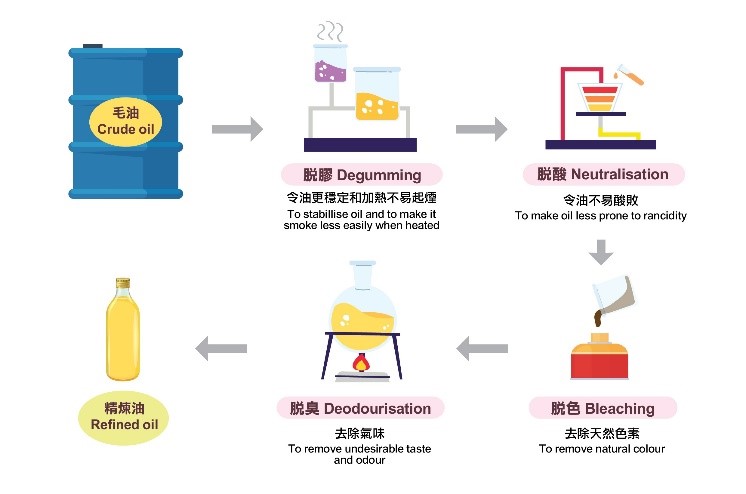
Refining of edible fats and oils
Unsaturated fatty acids in oils could promote the formation of GE in oils and diacylglycerol (DAG) is known to be the precursor. For vegetable oils, climate, soil, growth conditions, and harvesting techniques of the source plants are some of the factors affecting the levels of DAG in the oils and subsequently the levels of GE after refining. The formation of GE from DAG is temperature-dependent. It begins at about 200°C and becomes more significant at above 230°C.
How does GE get into our body?
Refined fats and oils are widely used in food manufacturing, which introduces GE into food products we consume. Researches and studies conducted by overseas authorities and organisations have demonstrated that GE is frequently found in edible fats and oils (e.g. margarine, sesame oil and peanut oil) and foods made with these oils (e.g. biscuits, French fries, potato chips and instant noodles). Although the amount of GE in different foods varies, GE levels are generally higher in palm oil and food products containing palm oil as an ingredient than in other types of oils and their related products.
After food containing GE is consumed, GE will be broken down in the human body and release glycidol. Research animal studies showed that glycidol is gene-damaging. However, there is currently no conclusive evidence that glycidol can have a similar effect in humans. Nonetheless, the European Union and countries like Australia and the United States have adopted the “As Low and Reasonably Achievable (ALARA)” principle, a precautionary approach to controlling the potential food safety risks from GE. Although the presence of a trace amount of GE in some food is unavoidable, the food industry should implement measures to minimise the levels of GE in food according to the ALARA principle. Likewise, consumers should maintain a balanced diet and eat less fats and oils as far as possible.
What CFS has done?
The Centre for Food Safety (CFS) has launched a number of initiatives to raise public awareness about GE in food and provide the trade with advice on how to reduce the levels of GE in food. Apart from disseminating food safety advice and messages regarding GE to the public through various channels, trade talks and seminars about GE were organised for the industry. Besides, risk assessment studies on edible fats and oils available in the local market were also conducted. The results showed that the average level of GE in local edible fats and oils was lower than that reported in similar studies conducted overseas.
The trade is advised to make reference to the Code of Practice Note 1 developed by the Codex Alimentarius Commission and select techniques that are appropriate to their processes and products in order to prevent and reduce the formation of GE in refined oils and food products made with refined oils. Consumers should maintain a balanced and varied diet to minimise the risk of exposure to contaminants from a limited range of food items. Preparing food at home with fresh ingredients can reduce the consumption of processed food items that contain the fats and oils concerned. Avoid excessive consumption of food that is rich in fats and oils (e.g. margarine) and food containing refined fats and oils (e.g. deep-fried products) can also reduce the exposure to GE in food.

Mascot ON in Lesson
In October 2023, the media reported that nearly 900 people were affected in a massive food poisoning outbreak caused by Campylobacter species in Japan. The incriminated food was nagashi sōmen, which are noodles flowing down a bamboo chute and being caught by diners with chopsticks as they float by. The pathogen was detected in the spring water sending the noodles down the chute. Travellers can savour local delicacies when travelling, but they should stay alert to threats to food safety. Let’s learn more about Campylobacters in food and travel-related food safety tips in this article.
Campylobacters are commonly found in the intestinal tracts of animals and humans. The most commonly reported Campylobacter species in human diseases is Campylobacter jejuni, followed by Campylobacter coli. These disease-causing Campylobacter species can only grow at above 30℃ but can tolerate higher growth temperatures, and their optimum growth temperature is 42℃. That said, Campylobacters have higher survival rates in food stored under refrigeration compared to food stored at room temperature. Moreover, a micro-aerobic environment, i.e. reduced oxygen environment, is favourable to the growth of most Campylobacter species. Oxygen comprises approximately 21% of the atmosphere, while these bacteria grow optimally at oxygen concentrations ranging from 3% to 5%. According to the literature, consuming as few as 500 Campylobacter cells can cause illnesses.
Gastrointestinal illnesses caused by Campylobacters can affect individuals of different age groups. Among them, children below the age of 5 and young adults aged between 15 and 29 are more prone to gastroenteritis. Its incubation period usually ranges from two to five days. The most common symptoms include watery diarrhoea or bloody diarrhoea, abdominal pain, fever, headache, nausea and/or vomiting, which usually last for 2 to 10 days. While most patients can recover on their own, some may need antibiotic treatment. The infection may be fatal to those with weakened immunity. In rare cases, the infection can be followed by long-term illnesses such as reactive arthritis and Guillain-Barré syndrome (GBS). GBS is a disease in which the body’s immune system attacks the nerves. GBS patients can experience muscle weakness or even paralysis for weeks.
Campylobacters are commonly found in most warm-blooded animals such as poultry, cattle, pigs, sheep and dogs. C. jejuni has a very varied reservoir but is mainly associated with poultry. C. coli is predominantly found in pigs. Inadequately cooked meats (especially poultry) is one of the sources of Campylobacters.
Other sources include unpasteurised milk and products, contaminated raw fruits and vegetables, contaminated water or cross-contaminated ready-to-eat food. Animal faeces can contaminate lakes and streams; the consumption of contaminated water has contributed to a number of global outbreaks. Fruits and vegetables can be contaminated through contact with soil or water containing animal faeces.
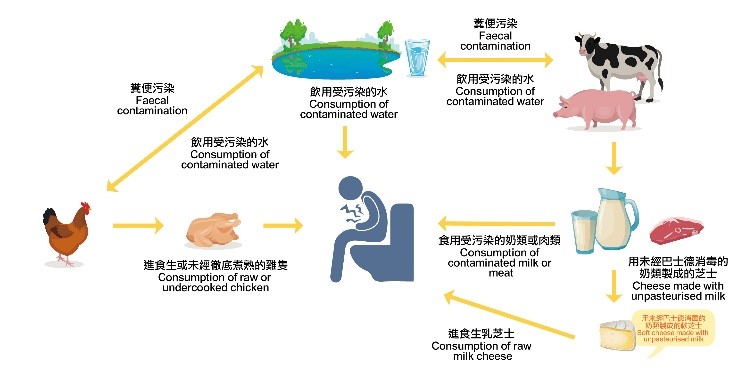
Transmission of Campylobacters via food and water
The outbreak mentioned above was traceable to contaminated spring water as the source of Campylobacters. Consumers should make careful food choices while travelling and take the following precautionary measures against food- or water-borne illnesses:
- Wash hands thoroughly before handling and consuming food.
- Choose beverages and food that are safe to eat, such as boiled water, bottled drinks, packaged beverages; do not eat raw or undercooked meat, poultry, seafood and eggs.
- Do not drink untreated water.
- Avoid ice in drinks if in doubt about its source or hygienic conditions.
- Buy food from hygienic and reliable shops; do not buy food from street vendors or other food outlets with poor environmental hygiene or improper handling of food.
- Avoid cooked or ready-to-eat food that has been kept at room temperature for hours.
- Avoid food that is not kept hot (above 60℃) or refrigerated (at or below 4℃) at buffets, markets, restaurants and street vendors.
- Peel fruits and vegetables if they are to be eaten raw; avoid those with damaged skin.
Dining Out
A ready-to-eat marinated pig oviduct sampleNote 1 collected by the Centre for Food Safety (CFS) from a food shop in Sham Shui Po was tested positive for the pathogen, SalmonellaNote 2. Upon investigation, it was suspected to be caused by cross-contamination of cooked food with raw food, possibly through unclean gloves. The CFS has instructed the shop to suspend the sale of the food product concerned, provided food safety and hygiene education to the staff, and requested them to conduct thorough cleaning and disinfection.
To prevent cross-contamination, food handlers should maintain good personal and environmental hygiene at all times. Wash hands properly before and after work and whenever changing job duties (e.g. handling food after handling rubbish) or when their hands get dirty. Clean and disinfect utensils and equipment after use. Use covered rubbish bins and empty them regularly. Keep food covered during display and storage. Cook food thoroughly and keep it out of the temperature danger zone. Consumers should consume snack food as soon as possible after purchase.


Safe Kitchen/Trade Talks/Food Safety Guidelines
Safe Kitchen
Introduction to “Safe Kitchen” Scheme
To facilitate the adoption of the “5 Keys to Food Safety” and Good Hygiene Practices (GHPs) by trade members, and ensure food safety in their daily operation, the CFS has integrated the existing channels of risk communication and launched a new platform, namely “Safe Kitchen”, to communicate with the trade. The platform provides food safety information of greater practical importance to meet the operational needs of catering outlets.
The “Safe Kitchen” platform disseminates up-to-date food safety information (including food safety guidelines and relevant legislative amendments) to the trade through a host of channels including WhatsApp, emails and dedicated websites. In response to food poisoning outbreaks in restaurants, the platform will also issue food alerts to remind the trade of the points to note in preventing future occurrences so that the risk of food poisoning can be minimised.
New dedicated websites and risk information exchange platforms will be rolled out under the “Safe Kitchen” Scheme. In addition, training materials tailor-made for the trade and workshops for kitchen staff will be provided to enhance food safety and hygiene awareness among them. Members of the trade are welcome to scan the QR code to download the registration form for the “Safe Kitchen” Scheme in order to receive the latest food safety information in a timely manner.

Trade Talks
Trade Talks 2024
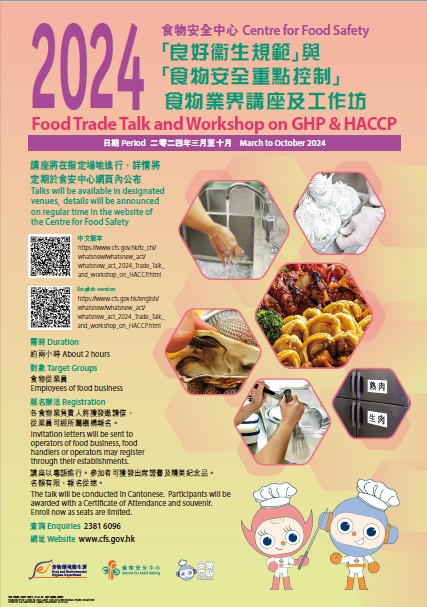
The CFS has organised food safety talks and workshops on GHPs for Food 2024 from March through October to publicise proper food handling to employees of food businesses, with a view to promoting GHPs for Food through active participation from the trade and its collaboration with the government, and encouraging the development of a Food Safety Plan in food processing, thereby enhancing food safety.

Food Safety Guidelines
Online Grocery Shopping and Delivery - Food Safety Advice for Food Businesses and Customers
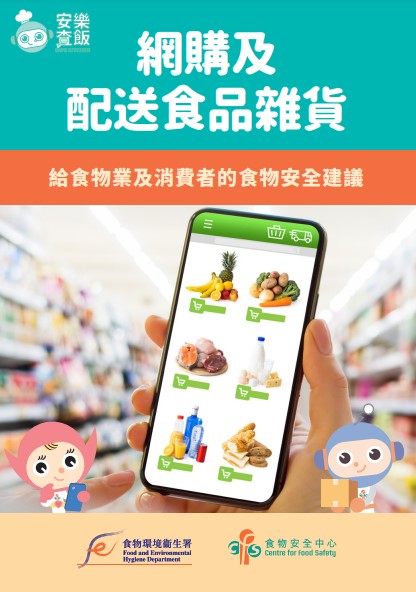
Online grocery shopping and delivery are becoming increasingly common, and related food safety issues are worth noting. Online shop operators and third-party delivery agents should implement appropriate measures in their operations to reduce food safety risks. To find out how to avoid contamination of or damage to food during preparation, storage and delivery, and how to provide consumers with clear information, including food labels, expiration dates and delivery arrangements, etc., please click the following link or scan the relevant QR code to browse or download the guidelines as reference.

News on CFS
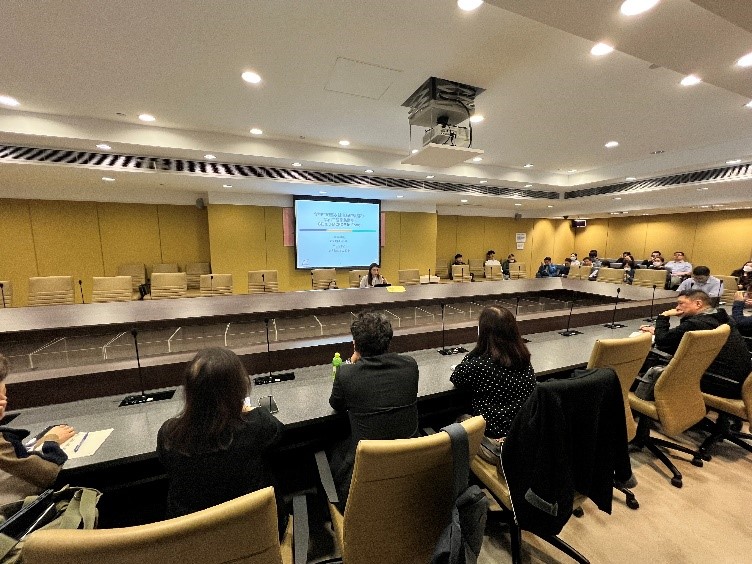

https://whatsapp.com/channel/0029VaMrUsUIXnlz5oAkZG1T


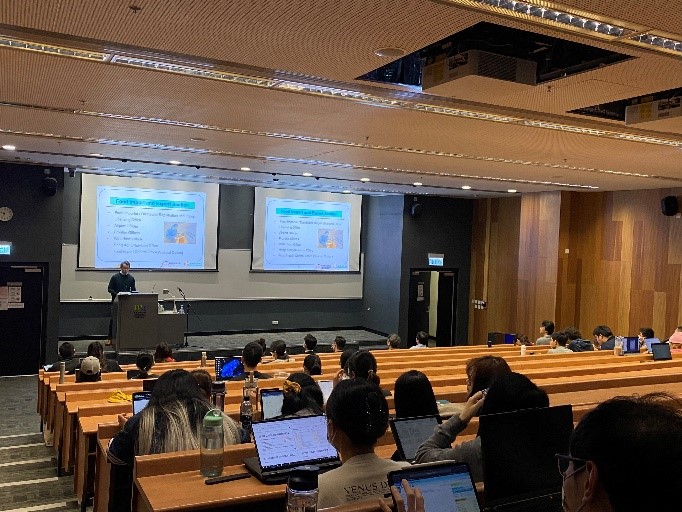
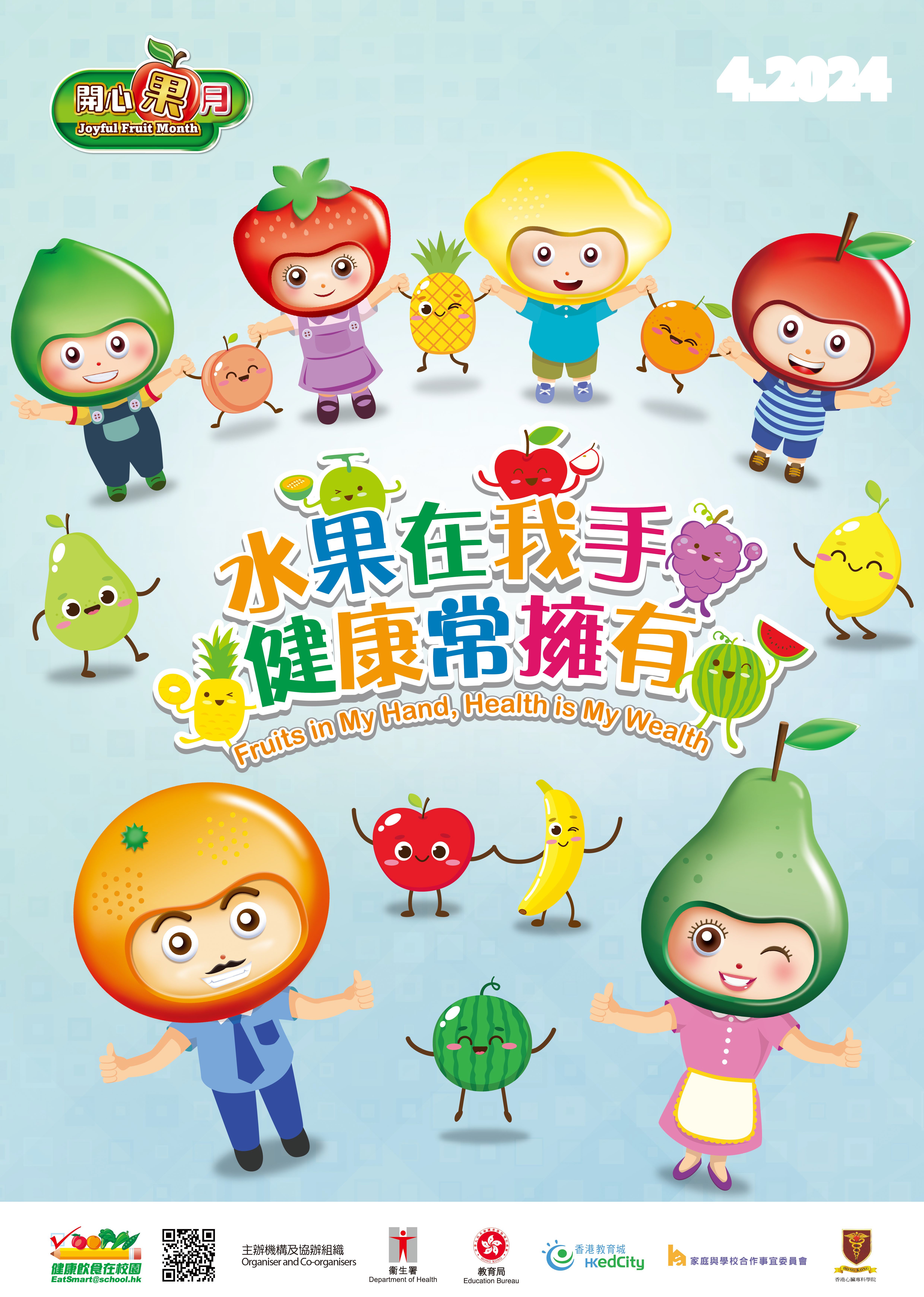
The CFS has always supported the “Joyful Fruit Month” initiated by the DH. The campaign aims to promote the habit of eating adequate fruit every day and has received widespread support from schools and various sectors of the community over the years.
In April this year, the CFS even put up community posters with the theme of “Joyful Fruit Month” in public markets under the FEHD to continue to create a cheerful atmosphere and disseminate health messages.
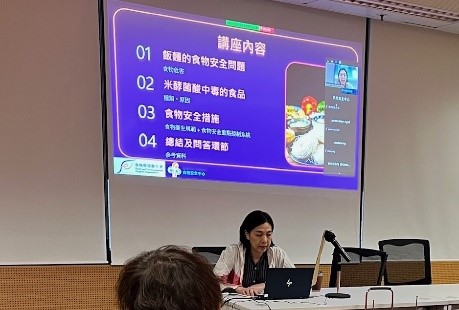
Ask Our Mascots
The intake of trans fatty acids (TFAs) can increase the risk of coronary heart disease. There are two major dietary sources of TFAs, namely ruminant products (e.g. milk and butter), where TFAs are naturally present, and bakery, deep-fried or margarine products, where industrially produced TFAs (IP-TFAs) can be found. The World Health Organization (WHO) targets limiting IP-TFAs in food as they are the major dietary source of TFAs and can be replaced with alternative ingredients.
In response to the call of WHO and the local action plan, the CFS has amended the regulations to ban partially hydrogenated oil (PHO), the main source of IP-TFAs, in food. The CFS’s recent risk assessment study on IP-TFAs in local food products found that a majority of the samples contain no or a low level of IP-TFAs. Only six samples (4%) contained more than the WHO guidance level of 2g IP-TFAs/100g total fat. As the amendment regulation on banning PHO came into effect on 1 December 2023, the food trade should ensure that their products do not contain PHO.
Recently, there were local pigs tested positive for African Swine Fever (ASF) virus. ASF is a highly contagious viral disease affecting pigs, but it does not infect humans.
To minimise the risk of ASF in slaughterhouses, a daily clearance arrangement has been implemented since June 2019, whereby all live pigs are slaughtered within 24 hours upon admittance into the slaughterhouses. Lairages are cleared out for thorough cleansing and disinfection every day. Live pig vehicles are thoroughly cleaned and disinfected every time before they leave the slaughterhouse, and vehicles carrying local and imported pigs are cleaned and disinfected in designated positions separated from each other. In addition, disinfection pools have been installed near the entrance gate to facilitate disinfection of wheels for pig-conveying trucks entering and leaving the slaughterhouse. All pigs have to undergo ante-mortem and post-mortem inspections before supplying to the market to ensure that they are fit for consumption.
Though ASF is not a zoonotic disease and causes no food safety concern, pork should be cooked thoroughly before consumption to reduce the risks caused by foodborne pathogens.
Enhancement Quiz
1. When did the amendment regulation on banning PHO come into effect?
- 1 October 2023
- 1 December 2023
- 1 January 2024
- 1 March 2024
2. Campylobacters can tolerate higher growth temperature. What is their optimum growth temperature?
- 32°C
- 42°C
- 52°C
- 62°C
3. To minimise the formation of process contaminants when using an air flyer, we should:
- Avoid cooking food at too high a temperature for too long
- Trim the fat present in the food before air-flying
- Parboil the food before air-flying
- All of the above

Diary of Mascot ON
Food Safety Tips for Using Air Fryers
The air fryerNote 1 is a popular home appliance as it is able to cook food quickly with little oil, with a resulting texture which resembles that produced by deep frying. Despite its name, it is actually a small convection oven with hot air circulated by a fan.
To prevent food poisoning, cook food thoroughly, especially for larger chunks of food. Do not overload air fryers. Turn the food occasionally when cooking. Like any high-temperature dry-heat cooking methodNote 2, air frying is prone to formation of process contaminants like acrylamide and polycyclic aromatic hydrocarbons (PAHs). To minimise their formation, do not cook food at too high a temperature for too long. Aim for a golden-brown colour when air frying starchy food. Trimming the fat present and parboiling the food before air-frying can also help to reduce the formation of process contaminants.
Consumers should maintain a balanced diet with plenty of vegetables and fruits and keep the total amount of fat and salt in check.

